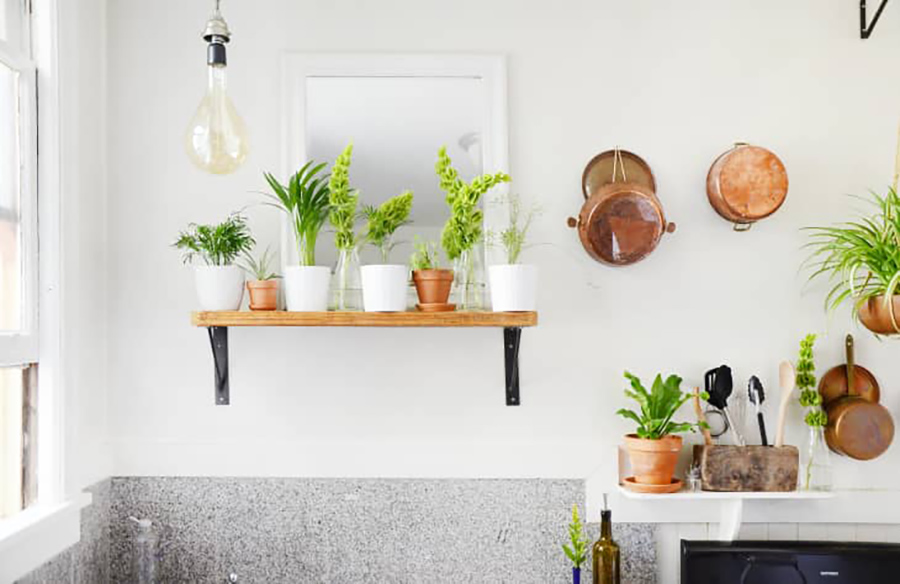Introduction
In the delicate balance between pet companionship and the love for indoor greenery, it’s crucial to ensure the well-being of our furry friends. While the allure of houseplants is undeniable, not all flora peacefully coexists with pets. Recognizing the potential hazards, we present a guide to pet-safe houseplants, accompanied by essential tips to foster a pet-friendly indoor garden.
Pet-Safe Plants
- Calathea: Jungle Vibes for Your Home
Calatheas, with their jungalow-worthy, vibrant leaves, stand out as a non-toxic choice for pet owners. Hailing from the South American rainforests, these mid-sized plants flourish in humidity and bright, indirect light. Planting them in glazed or plastic containers ensures optimal moisture levels, providing a safe and visually appealing addition to your living space.
- Spider Plant: Playful and Pet-Safe
The spider plant, with its wispy, long leaves, captivates cats without posing harm. To ensure their well-being, address common issues such as water stress. Maintain a watering routine, allowing the soil to dry slightly between sessions. Adequate ventilation, mimicking their native South African coastal habitat, ensures a thriving spider plant in your home.
- Parlor Palm: Versatile and Forgiving
Chamaedorea elegans, the parlor palm, adds a touch of elegance without compromising pet safety. Versatile in size, this non-toxic plant adapts well to lower light conditions and showcases resilience in drought. Indirect light and mindful watering, approximately once a week, contribute to the parlor palm’s hassle-free care.
- Pilea Peperomioides: The Friendship Plant
Pilea peperomioides, also known as the friendship plant, remains a preferred choice for its unique appearance and pet-friendly nature. Originating from China, this compact plant thrives in bright, indirect light. Adopting succulent-like watering practices, allowing the soil to dry completely, ensures a flourishing P. peperomioides.
- Echeveria: Succulent Beauty
Diverging from leafy plants, echeverias, common succulents, emerge as a pet-safe option. Native to dry landscapes, these plants boast various rosette shapes and colors. With shallow root systems, echeverias suit open terrariums or shallow containers. Careful not to overwater, these low-maintenance plants thrive in well-lit spaces.
- African Violet: Classic Elegance
African violets, revered as classic houseplants, add a touch of delicacy to your space. Originating from tropical eastern Africa, these blooms thrive in indirect to bright light. Employing bottom-watering techniques, with a tray underneath, ensures consistent moisture without endangering pets.
- Tillandsia: Air Plants for Pet-Friendly Charm
Tillandsias, commonly known as air plants, offer a unique, pet-safe charm. Thriving without soil, these epiphytic plants elevate bookshelves and coffee tables. Originating from tropical regions, maintaining warmth and moisture levels proves essential. Regular misting or weekly soaking in distilled water caters to their needs.
Toxic to Pets: Plants to Avoid
- Lily: A Lethal Beauty
True lilies from the Lilium genus, especially Stargazer, Easter, and Asiatic lilies, pose severe dangers to cats. Even minimal exposure, such as brushing against pollen, can lead to kidney failure. Pet owners are strongly advised to steer clear of these lethal plants.
- Peace Lily: Deceptive Elegance
Contrary to its name, peace lilies, or Spathiphyllums, are toxic to pets. The calcium oxalate crystals present in their tissues can cause severe irritation to the mouth and digestive tract. Pet owners should exercise caution and avoid bringing peace lilies into homes with pets.
- Dieffenbachia: Dumb Cane, Smart Choice to Avoid
Dieffenbachia, commonly known as dumb cane, may be easy to care for, but it poses risks to pets. With calcium oxalate crystals causing irritation, exposure can lead to symptoms like excessive drooling, licking, and, in severe cases, lethality. Pet owners should opt for safer alternatives.
- Pothos: Widespread, Yet Hazardous
Pothos, popular for their vining aesthetic, also contain calcium oxalate crystals. While forgiving in care, these plants can cause damage to pets’ gastrointestinal and respiratory systems if ingested. Considering their prevalence, pet owners must be cautious and explore pet-friendly alternatives.
Conclusion
Balancing a love for plants and the safety of our pets requires informed choices. Embracing pet-safe houseplants ensures a harmonious environment where both flora and fauna can thrive without compromise. Always conduct thorough research before introducing new plants into your home, and consult reputable sources for information on pet-friendly options.



















